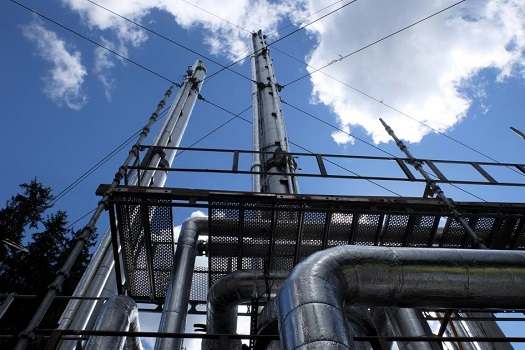
Views: 6
– Norway stored carbon dioxide for 25 years. Technology and experience have export value. The buoy is the social changes necessary for success.
Courtesy Oslo University by Elina Meltig: In Norway, carbon dioxide CO² is stored for 25 years. The philosophy was the same as it is now. Norway wants to store carbon dioxide at the bottom of the sea, explains researcher Rikke Bruhn, from the Department of Geosciences at the University of Oslo.
According to Bruhn, it is not the technology itself, but the surrounding structures, which is the barrier that must be overcome for the measure to work in a climate context.
On the storage side, Norway has a lot of knowledge, but it must further develop and reduce the cost of monitoring over a long period of time, so that it is possible to ensure that the CO 2 does not leak out of storage and rise again to the bottom of the sea. , says Bruhn.
She believes that the real challenge is the development of technology and cost-effective carbon capture and transport, and the establishment of value chains between the CO 2 producing industry, transport and storage operators.
These are value chains that didn’t exist until now. Then it must be scaled to a size that suits it, and then we must have a standardization of rules and how we handle and transport CO² across borders in Europe, explains Bruhn.
CO² import and technology export
Bruhn predicts that CO² could become a recipe for Norway in the future, allowing it to import CO² from countries like Germany. In addition, Norwegian carbon capture and storage technology and knowledge can become export goods.
“It’s a bit fair for us to take a step back, after being a major oil and gas exporter for many decades. The technology we invest in and spend money on can also be an export in itself,” she believes.
Anders Bjartnes, editor-in-chief of Energy and Climate, has followed the political game around carbon storage for many years. One of the main policy decisions was where to invest in a larger carbon capture plant. The choice fell on Norcem’s cement factory in Brevik.
“Cement production is an industrial sector where it is not possible to reduce emissions in any other way. The technology being developed in Grenland may perhaps be transferred to other facilities in Europe”, says Bjartnes.
A carbon capture plant is also planned at the waste incineration plant in Klemetsrud, south of Oslo.
“On Klemetsrud, you also can’t get rid of carbon dioxide in any way other than carbon capture. The Norwegian authorities want this project to receive support from the EU,” says Bjartnes.

Foreign Skepticism About CO² Storage
Although Norway has stored carbon for many years, there is skepticism about it in several countries, including Germany. Bjartnes believes it is important to gain political acceptance that it is safe to store it. It’s an important prerequisite for carbon storage to take place on a large scale, he explains.
The situation in Denmark is the same. Bruhn believes that much of the fear is due to the fact that people don’t know much about CO².
People don’t know it’s not explosive. They think of CO2 as dangerous and don’t want it in their own backyard. People fear it’s toxic, but we exhale CO² every day, explains Bruhn.
While Norwegians do not share the same skepticism, Bjartnes believes we can thank the oil industry itself.
Regardless of the vision of the oil industry, we are confident that oil tankers are good technologists and know what they are doing. There is confidence that offshore technology is working well and that is important to the vision of carbon capture and storage in this country.
How to store Carbon Dioxide
Carbon storage involves pumping carbon dioxide underground. The deposits have the same geological structure from which we extract oil and gas. According to Bruhn, carbon dioxide must be pumped deep, preferably 2-3 kilometers, to get the pressure and temperature that make it change from a gas to a liquid.
In liquid form, it takes up less space and therefore you can store more with the same volume in the warehouse. The CO² from the rock is pumped down, it must be porous, like a sandstone. Then the CO² fills all the cavities, like when you fill a bucket of sand on the beach with water. It is important that there is a sealing rock above the bearing, eg a slate, so that the CO² does not float again.
Liquid carbon dioxide is lighter than powder fluid around, which is usually saline. If you don’t have something to keep it down, it pops back up, says Bruhn.
Therefore, a lot of research is done on sealing rocks; that it’s tight and doesn’t crack when we pump CO² down and increase the pressure in the warehouse.
The price we pay
Carbon storage is not cheap, but according to Bjartnes we can consider it as a form of insurance.
It is difficult to see which extreme weather conditions and climate change trigger social change. That means cutting emissions is cheaper insurance than the risk of letting it go, he says.
Bjartnes also claims that rising prices for CO² emissions mean that it has become more favorable to try to store CO² than to emit it.
If the price of emissions is high enough, it’s worth saving. He believes Norway has made enough money from oil and gas so that we can also invest in storage technology.
A green shift in geosciences
Geology is an area that is very closely linked to the oil industry. Rikke Bruhn believes there is not necessarily a contradiction in terms of being part of the solution:
The geosciences are absolutely central to green change, because we’re going to need a huge number of geologists to find all the minerals we need to make battery technology, pull electrical cables to electrify the platform, people who can probe the seabed in connection. with the offshore wind, and people who can develop geothermal energy. Geoscience is central to many of these disciplines, says Bruhn.
Related article: Bonding carbon dioxide using broken concrete
Leave a Reply